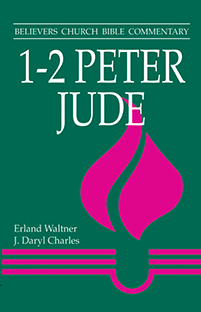The Ethical List as a Teaching Device (in 2 Peter)
![]() Home A B C D E F G H I J K L M N O P Q R S T U V W X Y Z Abbreviations Glossary
Home A B C D E F G H I J K L M N O P Q R S T U V W X Y Z Abbreviations Glossary
The ethical vocabulary of 2 Peter 1:5–7 presents us with a fascinating glimpse into the moral thought-world of Hellenistic culture. Although the grouping of ethical values into lists surfaces in diverse cultures of antiquity, the rhetorical use of ethical lists comes into full bloom in the moral doctrine of the Socratic philosophers, and particularly in the teaching of the Stoa. The use of the ethical catalog by NT writers derives from its function in Hellenistic and Jewish literature. With some exceptions, the theological motivation behind use of the catalog is owing primarily to the thought world of Hellenistic Judaism, in which the dualism of the righteous and the unrighteous comes to expression. In the NT, both strands—Hellenistic form and Jewish theological assumptions—merge in the Christian ethical tradition.
The recording of ethical lists in the Hellenistic world extends formally from the Homeric era. Preliterary types of the catalog that can be cited include crime registers, lists of character traits of those born under certain constellations, memorials to the deceased, and decrees of honor. A large number of inscriptions, especially gravesites and memorials, list virtues in honor of the said individual. Honors were typically bestowed upon military generals, doctors, judges, and officeholders.
The emergence of ethical catalogs in the Hellenistic period can be seen initially within an “academic” context and later in a more popular one. The ethical list has a decisive rhetorical function. It is a form of speech intended to instill praise or shame in the hearer or listener and incite to action. Vice and virtue lists perform this practical function equally in pagan Stoic as well as Christian usage. Because the Christian message was formed against the backdrop of Greco-Roman moral-social conditions, touchpoints between Stoic thought and the NT are numerous (e.g., Acts 17:16–34). While the two systems are radically different in the way each perceives the means to the ethical life, they nonetheless share common ethical terms, though the religious contexts in which they appear provide them with important nuances of meaning.
As a pedagogical device, the ethical catalog derives its force from a standardization of human or behavioral types. Over time, popular moral philosophers expanded the form of ethical catalogs to include new elements, especially additional vices. Preaching moral uplift in the marketplace, peripatetics found ethical lists to be a practical and effective rhetorical tool. In popular usage, the lists were far from the convoluted philosophical constructs that had been employed by “scholastic” moral philosophers. Practical needs of the masses propelled the use and extension of ethical lists in a popular format. People saw themselves in these lists, whether by vice or virtue.
In their form, Stoic ethical catalogs do not possess a rigid hierarchy of virtues so as to suggest a moral progression leading to an ethical climax, even when all the virtues stand in close connection with each other and constitute a natural unity. No particular order or arrangement of virtues came to characterize popular usage of lists, although a play on words was frequently achieved through the word order. Further, Stoic vice or virtue lists were not meant to be all-inclusive. The presence or absence of particular virtues in the list simply reflected the values or particular emphasis of the author.
Vice and virtue lists in the NT function in different ways. They may be used for the purpose of antithesis (e.g., Gal. 5:19–23; James 3:13–18), contrast (Titus 3:1–7), polemics (1 Tim. 1:9–10; 6:3–5; 2 Tim. 3:2–5), or instruction (2 Pet. 1:5–7). Occasionally, though not necessarily, alliteration or assonance, cadence, and inclusio (two similar terms bracketing a section) enhance their descriptions. A unified structure is hard to detect, and rhetorical motivation is not always apparent, with the notable exception of Philippians 4:8. In other texts, the virtues listed seem to build on one another and demonstrate a progression of sorts (2 Cor. 6:4–10; Gal. 5:22–23; Eph. 4:2–6; Col. 3:12–14; 2 Pet. 1:5–7).
In the Petrine catalog, faith can be seen as the foundation of the Christian ethic and love as the climax. The NT writers may be understood to appropriate a standard device for underscoring the necessity of the moral life as proof of one’s profession, both to the community and to the world.
While the form and function of the ethical list is borrowed by NT writers, it should be emphasized that the intellectual element of Greek philosophical reflection is not carried over into the NT by its writers. The reason for this can be traced to the fundamental divergence of Stoic and Christian outlooks. To the Greek mind, ethical requirements do not issue from a source of transcendent moral authority; instead, they are the fruit of rational education and knowledge, by which one comes to realize the fullness of human nature. Acquiring virtue for the Stoic is an absolute good, a goal in and of itself. Hence, the categories of sin and guilt—constituting the core of Hebrew and Christian theological understanding—have no real place in Stoic thought. While the Stoic is called to reflect, the Christian is called to repent and be redeemed. That is something the human mind is incapable of producing by itself.
| —J. Daryl Charles |
